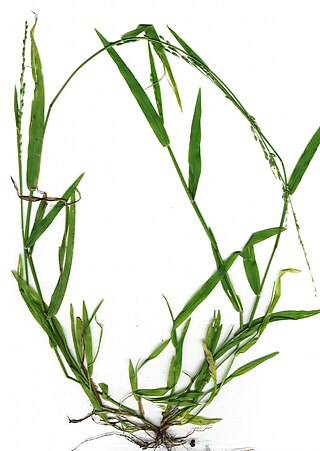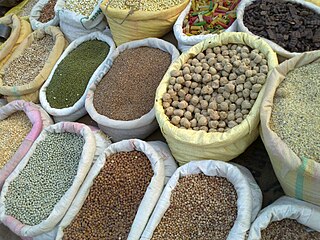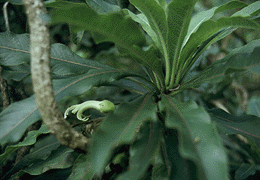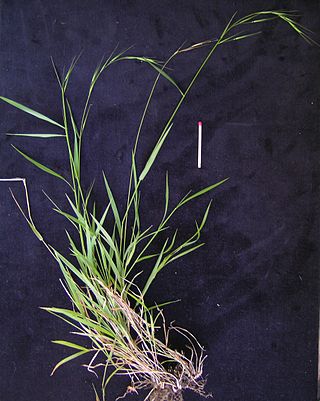
Wild rice, also called manoomin, mnomen, Psíŋ, Canada rice, Indian rice, or water oats, is any of four species of grasses that form the genus Zizania, and the grain that can be harvested from them. The grain was historically and is still gathered and eaten in North America and, to a lesser extent, China, where the plant's stem is used as a vegetable.

A perennial plant or simply perennial is a plant that lives more than two years. The term is often used to differentiate a plant from shorter-lived annuals and biennials. The term is also widely used to distinguish plants with little or no woody growth from trees and shrubs, which are also technically perennials.

Eriocoma hymenoides is a cool-season, perennial bunchgrass with narrow, rolled leaf blades. It is native to western North America east of the Cascades from British Columbia and Alberta south to southern California, northeastern Mexico, and Texas.

Paspalum is a genus of plants in the grass family.

Ehrharta is a genus of plants in the grass family.

Ehrharta erecta is a species of grass commonly known as panic veldtgrass. The species is native to Southern Africa and Yemen. It is a documented invasive species in the United States, New Zealand, Australia, southern Europe, and China.

Themeda triandra is a species of C4 perennial tussock-forming grass widespread in Africa, Australia, Asia and the Pacific. In Australia it is commonly known as kangaroo grass and in East Africa and South Africa it is known as red grass and red oat grass or as rooigras in Afrikaans. Kangaroo grass was formerly thought to be one of two species, and was named Themeda australis.
Amphibolis antarctica is a species of flowering plant in the family Cymodoceaceae. It is referred to by the common names wire weed or sea nymph, and is a seagrass found in coastal waters of southern and western Australia.

Paspalum scrobiculatum, commonly called Kodo millet or Koda millet, is an annual grain that is grown primarily in Nepal and also in India, Philippines, Indonesia, Vietnam, Thailand, and in West Africa from where it originated. It is grown as a minor crop in most of these areas, with the exception of the Deccan plateau in India where it is grown as a major food source. It is a very hardy crop that is drought tolerant and can survive on marginal soils where other crops may not survive, and can supply 450–900 kg of grain per hectare. Kodo millet has large potential to provide nourishing food to subsistence farmers in Africa and elsewhere.

Ehrharta calycina is a species of grass known by the common names perennial veldtgrass and purple veldtgrass.

Gahnia grandis is a tussock-forming perennial plant found in southeastern mainland Australia and Tasmania.

A grain is a small, hard, dry fruit (caryopsis) – with or without an attached hull layer – harvested for human or animal consumption. A grain crop is a grain-producing plant. The two main types of commercial grain crops are cereals and legumes.

Clermontia pyrularia is a rare species of flowering plant in the bellflower family known by the common names Hamakua clermontia and pear clermontia. It is one of several Hawaiian lobelioids in genus Clermontia that are known as ʻoha wai and haha. It is endemic to the island of Hawaiʻi, where there is one remaining wild population containing 15 individuals and several propagated individuals that have been planted in protected habitat. This is a federally listed endangered species of the United States.

Coronidium scorpioides, commonly known as the button everlasting, is a perennial herbaceous shrub in the family Asteraceae found in Australia. Previously known as Helichrysum scorpioides, it was placed in the newly described genus Coronidium in 2008.

Adenanthos sericeus subsp. sericeus, commonly known as coastal woollybush, is a shrub native to the south coast of Western Australia. It has bright red but small and obscure flowers, and very soft, deeply divided, hairy leaves. It is the western subspecies of Adenanthos sericeus, occurring mostly in the vicinity of King George Sound.
The Black Andrew Nature Reserve is a protected nature reserve located on the south west slopes of New South Wales, Australia. The 1,559-hectare (3,850-acre) reserve is situated on the southern shore of Burrinjuck Dam on the Murrumbidgee River, an important reservoir for the Murrumbidgee Irrigation Area.

Damasonium minus is a species of flowering plant in the water-plantain family known by the common names starfruit and star-fruit. It is native to Australia, where it occurs everywhere except the Northern Territory. It is perhaps best known as an agricultural weed. It is a major weed of Australian rice crops.

Dr Meredith Leigh Mitchell an Australian agronomist. She is a senior research scientist with the Victorian Department of Environment and Primary Industries.

Microlaena is a genus of flowering plant in the family Poaceae, native to areas from Java through Australia to New Zealand. The genus was established by Robert Brown in 1810.
Cyathochaeta stipoides is a sedge of the family Cyperaceae that is native to Australia.


















